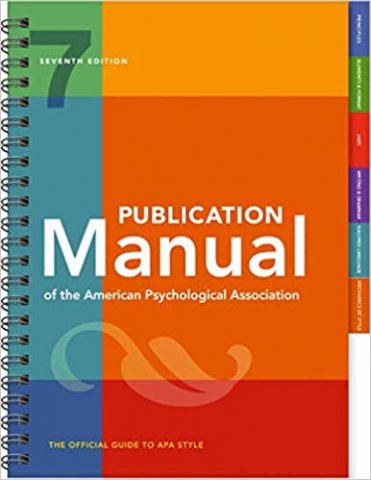
By David Shaffer
After a reign of ten years over the scholarly publications world of the social sciences, including ELT, the American Psychological Association’s Publication Manual (APA, 2010) abdicated to the seventh edition of the Publication Manual (APA 2020). APA (2020) brings with it a number of significant changes over the sixth edition, several of which are changes to frequently used items and which tend to simplify formatting. This article deals with some of the most significant APA changes in formatting for (1) references and (2) in-text citations, two related categories that often prove to be the most complicated for research paper writers.
1. Reference Changes
.
Publisher Location
The change that is so obvious by its absence from the reference is the elimination of publisher location. This is because online searching has made locating a reference so easy without knowledge of the location of the publisher and because many of the major publishing houses list multiple locations for a single work (APA, 2020, p. 295). The following are examples of how publisher location was dealt with in the old, sixth edition and in the new, seventh edition, respectively:
Calkins, L. (2020). Teaching writing. Plymouth, NH: Heinemann.
Calkins, L. (2020). Teaching writing. Heinemann.
(Note. In all the example pairs appearing in this article, the APA 6th edition style appears first, and the new APA 7th edition style appears second, the latter highlighted in blue font.)
URL Formatting
Because the internet is still relatively young and internet technology is rapidly changing, changes in formatting of online locations also occur frequently. APA no longer requires “Retrieved from” or “Available from” to appear in front of a URL (notice that https is not capitalized):
Graddol, D. (2006). English next. British Council. Available from https://www.teachingenglish.org.uk/article/english-next
Graddol, D. (2006). English next. British Council. https://www.teachingenglish.org.uk/article/english-next
DOI Formatting
APA prefers that the DOI (digital object identifier) rather than the standard URL be used for journal articles, provided the article has a DOI. This change makes the DOI notation a bit longer but now brings APA in line with the more commonly used DOI notation:
Thompson, N., & Pascal, J. (2012). Developing critically reflective practice. Reflective Practice: International and Multidisciplinary Perspectives, 13(2), 311–325. doi:10.1080/14623943.2012.657795
Thompson, N., & Pascal, J. (2012). Developing critically reflective practice. Reflective Practice: International and Multidisciplinary Perspectives, 13(2), 311–325. https://doi.org/10.1080/14623943.2012.657795
Multiple-Author References
It was previously the case that when a work had more than seven authors, the first six and the last-named author were recorded and separated by an ellipsis. In the newest edition (APA, 2020), the names of all authors are recorded up to and including 20. Only when a work has 21 or more authors are the first 19 and final author recorded with an ellipsis between them:
APA (2010)
Adams, A. A., Baker, B. B., Carlson, C. C., Dobson, D. D., Erikson, E. E., Fritz, F. F., … Zachary, Z. Z. (2020). Title of work. Publisher.
APA (2020)
Adams, A. A., Baker, B. B., Carlson, C. C., Dobson, D. D., Erikson, E. E., Fritz, F. F., Giles, G. G., Horwitz, H. H., Ickes, I. I., Jamal, J. J., Kagan, K. K., Lightbown, L. L., Maley, M. M., Norton, N. N., Ortega, O. O., Pennycook, P. P., Quinn, Q. Q., Richards, R. R., Scholl, S. S., … Zachary, Z. Z. (2020). Title of work. Publisher.
2. In-Text Citations
.
Multiple-Author Citations
It was previously the case that for both parenthetical and narrative multiple-author citations, all authors were recorded up to and including five authors in the first citation. For a work with six or more authors, the first author’s name and “et al.” were used. In APA (2020), the first author’s name and “et al.” are used for the first and subsequent citations for all works with three or more authors:
APA (2010)
Narrative Citation (first citation): In Adams, Baker, and Carlson (2020) …
Narrative Citation (subsequent): In Adams et al. (2020) …
Parenthetical Citation (first citation): … (Adams, Baker, & Carlson, 2020) …
Parenthetical Citation (subsequent): … (Adams et al., 2020) …
APA (2020)
Narrative Citation (first and subsequent): In Adams et al. (2020) …
Parenthetical Citation (first & subsequent): … (Adams et al., 2020) …
References
APA. (2010). Publication manual of the American Psychological Association (6th ed.). American Psychological Association.
APA. (2020). Publication manual of the American Psychological Association (7th ed.). American Psychological Association.
The Author
David Shaffer, PhD, has been involved in KOTESOL publications since 1998. He is currently the Publications Committee chair and a past president of KOTESOL, and he also serves on the Research Committee. Dr. Shaffer began his teaching career at Chosun University in the same year that Everland opened in Yongin. He has owned (and often referred to) each new spiral-bound edition of APA’s Publications Manual since 2002.


